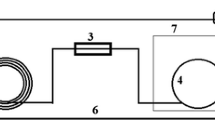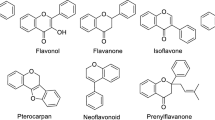Abstract
Stir bar sorptive extraction (SBSE) coupled with gas chromatography–mass spectrometry–olfactometry (GC–MS–O) allows for isolation and identification of aroma compounds in minimal sample preparation time. By means of this extraction technique in direct sample immersion, an independent approach of aroma dilution analysis (ADA) for the rapid determination of flavor dilution (FD) factors was developed based on dilution of the carrier gas flow. The used gas chromatography system equipped with a thermal desorption unit (TDU) and a cooled injection system (CIS) allowed to independently split the gas flow during thermodesorption and sample injection, respectively. The resulting overall split ratio ratios corresponded to the dilution factors. The developed method based on combining both splitting options allowed to determine FD factors in the range from 4 to 8192 in a reliable and reproducible manner. Validation of the method was performed with an aqueous solution containing 12 authentic standards, and a high linearity was confirmed for the binary logarithmic relationship between the peak area and the overall split ratio.


Similar content being viewed by others
Abbreviations
- ADA:
-
Aroma dilution analysis
- AEDA:
-
Aroma extract dilution analysis
- CIS:
-
Cooled injection system
- DI:
-
Direct immersion
- FD:
-
Flavor dilution
- GC:
-
Gas chromatography
- HS:
-
Headspace
- MS:
-
Mass spectrometry
- O:
-
Olfactometry
- ODP:
-
Olfactory detection port
- RSTD:
-
Relative standard deviation
- SAFE:
-
Solvent-assisted flavor evaporation
- SBSE:
-
Stir bar sorptive extraction
- SDE:
-
Simultaneous distillation–extraction
- SIM:
-
Selected ion monitoring
- SPME:
-
Solid-phase microextraction
- SR:
-
Split ratio
- TDU:
-
Thermal desorption unit
References
Schieberle P, Grosch W (1987) Evaluation of the flavour of wheat and rye bread crusts by aroma extract dilution analysis. Z Lebensm Unters Forsch 185(2):111–113. https://doi.org/10.1007/BF01850088
Schieberle P (1995) New developments in methods for analysis of volatile flavor compounds and their precursors. In: Gaonkar AG (ed) Characterization of food: emerging methods. Elsevier, Amsterdam, pp 403–431
Engel W, Bahr W, Schieberle P (1999) Solvent assisted flavour evaporation - a new and versatile technique for the careful and direct isolation of aroma compounds from complex food matrices. Eur Food Res Technol 209(3–4):237–241. https://doi.org/10.1007/s002170050486
Pico J, Tapia J, Bernal J et al (2017) Comparison of different extraction methodologies for the analysis of volatile compounds in gluten-free flours and corn starch by GC/QTOF. Food Chem. https://doi.org/10.1016/j.foodchem.2017.06.157
Barba C, Thomas-Danguin T, Guichard E Comparison of stir bar sorptive extraction in the liquid and vapour phases, solvent-assisted flavour evaporation and headspace solid-phase microextraction for the (non)-targeted analysis of volatiles in fruit juice. LWT Food Sci Technol https://doi.org/10.1016/j.lwt.2016.09.015
Majcher M, Jeleń HH (2009) Comparison of suitability of SPME, SAFE and SDE methods for isolation of flavor compounds from extruded potato snacks. Int Year Potato 22(6):606–612. https://doi.org/10.1016/j.jfca.2008.11.006
Guth H, Grosch W (1993) Identification of potent odourants in static headspace samples of green and black tea powders on the basis of aroma extract dilution analysis (AEDA). Flavour Fragr J 8(4):173–178. https://doi.org/10.1002/ffj.2730080402
Hinterholzer A, Schieberle P (1998) Identification of the most odour-active volatiles in fresh, hand-extracted juice of Valencia late oranges by odour dilution techniques. Flavour Fragr J 13(1):49–55. https://doi.org/10.1002/(SICI)1099-1026(199801/02)13:1<49:AID-FFJ691>3.0.CO;2-S
Fritsch HT, Schieberle P (2005) Identification based on quantitative measurements and aroma recombination of the character impact odorants in a Bavarian Pilsner-type beer. J Agric Food Chem 53(19):7544–7551. https://doi.org/10.1021/jf051167k
Jelen HH, Majcher M, Dziadas M (2012) Microextraction techniques in the analysis of food flavor compounds: a review. Anal Chim Acta 738:13–26. https://doi.org/10.1016/j.aca.2012.06.006
Wardencki W, Michulec M, Curylo J (2004) A review of theoretical and practical aspects of solid-phase microextraction in food analysis. Int J Food Sci Tech 39(7):703–717. https://doi.org/10.1111/j.1365-2621.2004.00839.x
David F, Sandra P (2007) Stir bar sorptive extraction for trace analysis. J Chromatogr A 1152(1–2):54–69. https://doi.org/10.1016/j.chroma.2007.01.032
Bicchi C, Iori C, Rubiolo P et al (2002) Headspace Sorptive Extraction (HSSE), Stir Bar Sorptive Extraction (SBSE), and Solid Phase Microextraction (SPME) applied to the analysis of roasted arabica coffee and coffee brew. J Agric Food Chem 50(3):449–459. https://doi.org/10.1021/jf010877x
Maggi L, Zalacain A, Mazzoleni V et al (2008) Comparison of stir bar sorptive extraction and solid-phase microextraction to determine halophenols and haloanisoles by gas chromatography-ion trap tandem mass spectrometry. Talanta 75(3):753–759. https://doi.org/10.1016/j.talanta.2007.12.013
Contini M, Esti M (2006) Effect of the matrix volatile composition in the headspace solid-phase microextraction analysis of extra virgin olive oil. Food Chem 94:143–150
Ouyang G, Pawliszyn J (2008) A critical review in calibration methods for solid-phase microextraction. Anal Chim Acta 627(2):184–197. https://doi.org/10.1016/j.aca.2008.08.015
Caven-Quantrill DJ, Buglass AJ (2006) Comparison of micro-scale simultaneous distillation-extraction and stir bar sorptive extraction for the determination of volatile organic constituents of grape juice. J Chromatogr A 1117(2):121–131. https://doi.org/10.1016/j.chroma.2006.03.091
Feng Y, Cai Y, Sun-Waterhouse D et al (2015) Approaches of aroma extraction dilution analysis (AEDA) for headspace solid phase microextraction and gas chromatography–olfactometry (HS-SPME–GC–O): altering sample amount, diluting the sample or adjusting split ratio? Food Chem 187:44–52. https://doi.org/10.1016/j.foodchem.2015.03.138
Hwan Kim T (2003) Aroma dilution method using GC injector split ratio for volatile compounds extracted by headspace solid phase microextraction. Food Chem 83(1):151–158. https://doi.org/10.1016/S0308-8146(03)00221-8
Zhang Y, Fraatz MA, Horlamus F et al (2014) Identification of potent odorants in a novel nonalcoholic beverage produced by fermentation of wort with shiitake (Lentinula edodes). J Agric Food Chem 62(18):4195–4203. https://doi.org/10.1021/jf5005463
Trapp T, Zajul M, Ahlborn J et al (2017) Submerged cultivation of Pleurotus sapidus with molasses: aroma dilution analyses by means of solid phase microextraction and stir bar sorptive extraction. J Agric Food Chem. https://doi.org/10.1021/acs.jafc.6b05292
Sasaki T, Koshi E, Take H et al (2017) Characterisation of odorants in roasted stem tea using gas chromatography–mass spectrometry and gas chromatography-olfactometry analysis. Food Chem 220:177–183. https://doi.org/10.1016/j.foodchem.2016.09.208
Ibáñez E, López-Sebastián S, Ramos E et al (1998) Analysis of volatile fruit components by headspace solid-phase microextraction. Food Chem 63(2):281–286. https://doi.org/10.1016/S0308-8146(98)00001-6
Havemose MS, Justesen P, Bredie W et al (2007) Measurement of volatile oxidation products from milk using solvent-assisted flavour evaporation and solid phase microextraction. Int Dairy J 17:746–752
Lestremau F, Desauziers V, Fanlo JL (2001) Formation of artefacts during air analysis of volatile amines by solid-phase micro extraction. Analyst 126(11):1969–1973. https://doi.org/10.1039/B105099K
Adams A, van Lancker F, de Meulenaer B et al (2012) On-fiber furan formation from volatile precursors: a critical example of artefact formation during solid-phase microextraction. J Chromatogr B Anal Technol Biomed Life Sci 897:37–41. https://doi.org/10.1016/j.jchromb.2012.04.005
Ochiai N, Sasamoto K, Ieda T et al (2013) Multi-stir bar sorptive extraction for analysis of odor compounds in aqueous samples. J Chromatogr A 1315:70–79. https://doi.org/10.1016/j.chroma.2013.09.070
Ochiai N, Sasamoto K, Kanda H et al (2008) Sequential stir bar sorptive extraction for uniform enrichment of trace amounts of organic pollutants in water samples. J Chromatogr A 1200(1):72–79. https://doi.org/10.1016/j.chroma.2008.05.069
Sgorbini B, Cagliero C, Cordero C et al (2012) New medium-to-high polarity twister coatings for liquid and vapour phase sorptive extraction of matrices of vegetable origin. J Chromatogr A 1265:39–45. https://doi.org/10.1016/j.chroma.2012.09.097
Serrano La, de Hoz K, Salinas MR, Ferrandino A (2016) Different coatings for the HS-SBSE grape volatile analysis in model solution: preliminary results. Food Chem 212:814–820. https://doi.org/10.1016/j.foodchem.2016.06.047
Acknowledgements
This study was financially supported by the excellence initiative of the Hessian Ministry of Science and Art which encompasses generous grants for the LOEWE centre “Insect Biotechnology and Bioresources” and “HessenModellProjekte” (Project No. 478/15-20).
Author information
Authors and Affiliations
Corresponding author
Ethics declarations
Conflict of interest
The authors declare that they have no conflict of interest.
Compliance with ethics requirements
This article does not contain any studies with human or animal subject.
Electronic supplementary material
Below is the link to the electronic supplementary material.
Rights and permissions
About this article
Cite this article
Trapp, T., Jäger, D.A., Fraatz, M.A. et al. Development and validation of a novel method for aroma dilution analysis by means of stir bar sorptive extraction. Eur Food Res Technol 244, 949–957 (2018). https://doi.org/10.1007/s00217-017-3003-2
Received:
Revised:
Accepted:
Published:
Issue Date:
DOI: https://doi.org/10.1007/s00217-017-3003-2




